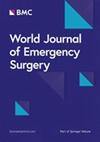虚弱、肌肉减少和身体状况对急诊剖腹手术患者死亡率的影响
IF 5.8
1区 医学
Q1 EMERGENCY MEDICINE
引用次数: 0
摘要
虚弱和肌肉减少症已被独立证明可以预测急诊剖腹手术(EmLap)的死亡率,两者都可能表明身体状况不佳。我们的目的是评估EmLap患者的虚弱、肌肉减少症和身体状况的患病率,并探讨这些因素与30天、90天和1年死亡率之间的关系。回顾性分析前瞻性维持的急诊剖腹手术和腹腔镜苏格兰审计(ELLSA)数据库(2017-2019),其中包括≥18岁接受EmLap的患者。采用临床虚弱量表(CFS)对虚弱进行分类(评分≥4分为虚弱)。用总腰肌指数(TPI)评估肌肉减少症。不良生理状态(PPS)被美国麻醉医师协会生理状态分类(ASA)定义为≥4。采用二元逻辑回归和fisher精确检验进行统计分析。215例患者纳入研究,其中57.2%为女性,中位年龄64岁。虚弱者占17.2%,肌肉减少者占25.1%,PPS患者占14.4%;3.3%的人三个因素都有。体弱多病患者30天(p = 0.003)、90天(p = 0.006)和1年死亡率(p = 0.032)均显著增高。身体状况较差的患者在30天(p < 0.001)、90天(p < 0.001)和1年(p = 0.001)的死亡率也明显较高。骨骼肌减少症患者在1年内的死亡风险没有显着差异。与没有上述三种因素的患者相比,有上述三种因素的患者的30天(p = 0.003)、90天(p = 0.046)和1年死亡率(p = 0.108)均显著高于无上述三种因素的患者。虚弱、肌肉减少症和PPS在EmLap中普遍存在。虚弱和PPS与短期和长期死亡率独立相关,但与肌肉减少症无关。虽然三个因素之间存在重叠,但需要更多的研究来了解复杂的相互作用。本文章由计算机程序翻译,如有差异,请以英文原文为准。
The influence between frailty, sarcopenia and physical status on mortality in patients undergoing emergency laparotomy
Frailty and sarcopenia have been independently shown to predict mortality in emergency laparotomy (EmLap), and both can be indicative of poor physical status. We aim to assess the prevalence of frailty, sarcopenia, and physical status in EmLap and explore the relationship between these factors and 30-day, 90-day and 1-year mortality. Retrospective analysis was performed on prospectively maintained Emergency Laparotomy and Laparoscopic Scottish Audit (ELLSA) database (2017–2019) which included patients ≥ 18 years who underwent EmLap. Clinical frailty scale (CFS) was used to classify frailty (score ≥ 4 as frail). Sarcopenia was assessed using total psoas index (TPI). Poor physical status (PPS) was defined by American Society of Anaesthesiologists physical status classification (ASA) ≥ 4. Binary logistic regression and fisher’s exact tests were used for statistical analysis. 215 patients were included in the study, with 57.2% female and median age of 64 years. Frailty was present in 17.2%, sarcopenia in 25.1% and 14.4% had PPS; 3.3% had all three factors. Frail patients had significantly higher risk for 30-day (p = 0.003), 90-day (p = 0.006) and 1-year mortality (p = 0.032). Patients with poor physical status also showed significantly higher mortality at 30-day (p < 0.001), 90-day (p < 0.001) and 1-year (p = 0.001). Sarcopenic patients did not show significant differences in mortality risks up to 1 year. Patients with all three factors had significantly higher 30-day (p = 0.003), 90-day (p = 0.046) and 1-year mortality (p = 0.108) compared to patients who had none of the factors. Frailty, sarcopenia, and PPS are prevalent in EmLap. Frailty and PPS were independently associated with short and long-term mortality, but not sarcopenia. While overlap exists between three factors, more research is required to understand the complex interplay.
求助全文
通过发布文献求助,成功后即可免费获取论文全文。
去求助
来源期刊

World Journal of Emergency Surgery
EMERGENCY MEDICINE-SURGERY
CiteScore
14.50
自引率
5.00%
发文量
60
审稿时长
10 weeks
期刊介绍:
The World Journal of Emergency Surgery is an open access, peer-reviewed journal covering all facets of clinical and basic research in traumatic and non-traumatic emergency surgery and related fields. Topics include emergency surgery, acute care surgery, trauma surgery, intensive care, trauma management, and resuscitation, among others.
 求助内容:
求助内容: 应助结果提醒方式:
应助结果提醒方式:


